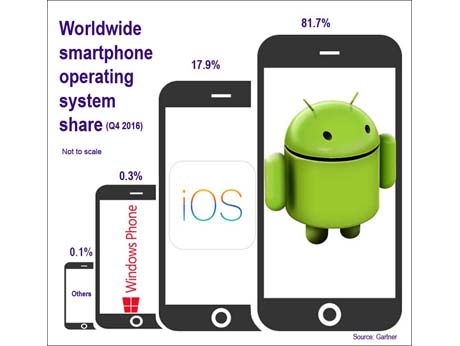
Google's operating system for smartphones has near global dominance, with Apple's iOS a distant second.
Bangalore, February 20 2017: What lies beneath the glossy face of your mobile phone? Which operating system (OS) makes it tick? Time was, when we never knew or cared. When mobile phones first became a global phenomenon in 2000, most of them ran an OS called Symbian.
Windows launched a phone-like Pocket PC and Blackberry launched the --well-- Blackberry, both in 2002, with their proprietary operating systems. But Symbian made most phones tick, including the classic Nokia 3310 that sold over 100 million units and was many Indians their first mobile handset. HMD, the Finnish company that bought out Nokia's phone business is all set to relaunch the 3310 in a new 2017 avatar, later this month, possibly at the Mobile World Congress in Barcelona. But it won't run Symbian which has faded away as a phone OS .
It will in all probability run Android, the mobile operating system that Google unveiled in 2008, in partnership with Intel, Dell and half a dozen phone makers like HTC, Samsung, Motorola, LG and Sony who formed the Open Handset Alliance. "Open" was a reaction to the closed and proprietary iOS that Apple chose to use when it launched the first iPhone just a year earlier.
Since then the spread of Android has been steady and systematic. Microsoft launched a Windows Phone design with a new OS with that name in 2010, which continues to command a small but loyal market especially as a system to provide a smooth cross over from PCs via Tablets.
An attempt to create another open Linux-based mobile OS - MeeGo -- by Intel and Nokia in 2011, was a flop. But Mozilla, the Open organisation behind the Firefox desktop OS, created a phone OS in 2012 which soldiers on. Two Indian brands, Intex and Spice were among the world's first to launch Firefox-fuelled phones in 2014, but such handsets are thin on the ground now..... because Android grows and grows.
A report by tech analyst Gartner, earlier this month finds that in the smartphone OSmarket, Android has extended its lead by capturing nearly 82 percent of the total market in the fourth quarter of 2016.
If you take the calendar year 2016, Android also grew its market share by 3.2 % to reach an 84.8 percent share. One reason could be that Google entered the phone hardware arena with its own handset -- Pixel -- last year, and seemed to be positioned as a competitor to Apple's iPhone.
|Says Anshul Gupta, research director at Gartner: "The entry of Google's Pixel phone has made the premium Android smartphone offering more competitive, while the re-entry of HMD (Nokia) in the basic (mid-tier) smartphone category, is set to further increase the competition in emerging markets."
Gartner's data for "Worldwide Smartphone Sales to End Users by Operating System" in the last quarter of 2016, shows that Android's 81.7% market share was achieved by its presence on 352. 67 million handsets. Next is Apple iOS on over 77 million phones, giving it a 17.9 % market share. Windows is present on 1.1 devices giving it a 0.3 % share of the OS market. All other operating systems add up to just 0.1 % share.
---------------------------------------------------------------------------------------------------------------------------------------------------------------------------------------------------
What is an Operating System
An operating system (OS) is software that, after being loaded into the computer by an initial boot programe, manages a computer’s resources, controlling the flow of information into and from a main processor.
OSs perform complex tasks, such as memory management, control of displays and other input/output peripheral devices, networking and file management, and other resource allocation functions betweensoftware and system components.
The OS provides the foundation on which applications, middleware and other infrastructure components function.
An OS usually provides user interfaces, such as command-lineshell and GUI, for interaction between user and computer. ( source: Gartner)
------------------------------------------------------------------------------------------------------------------------------------------------------------------------------------------------------